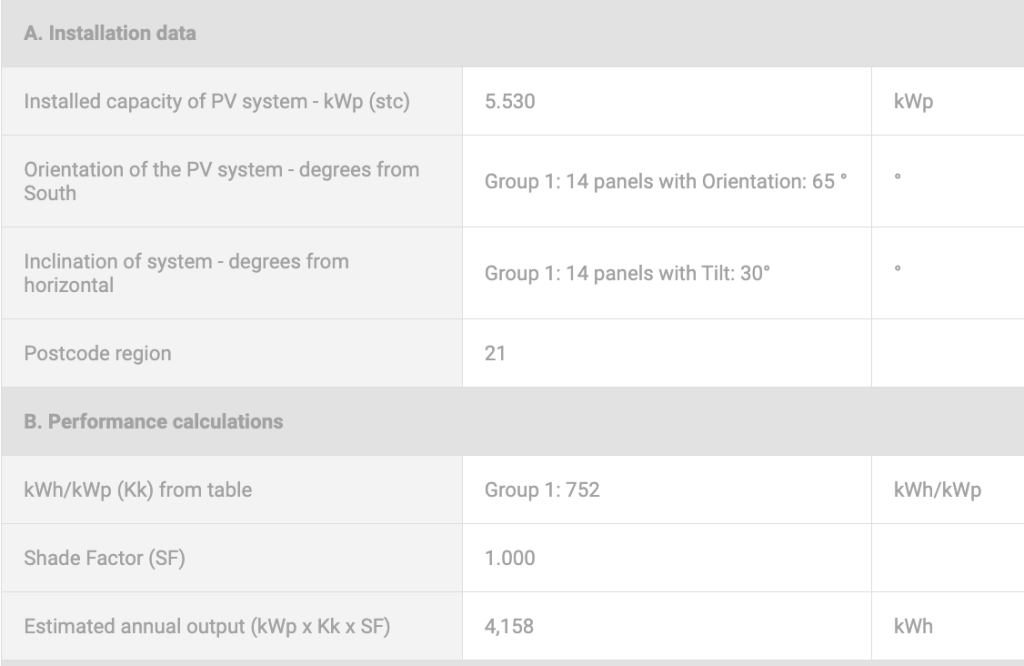Homeowners who are interested in installing solar PV systems on their homes are often shown some calculations, such as how much energy their specific system is estimated to produce each year. First Class Solar provides this information free of charge to interested homeowners, so they can compare this with their current electric usage, understand what difference solar would make for them and then decide for themselves whether solar is the right investment for their home. We use standardised methods to provide these estimates, but as we all know, there can be lots of variables to consider, which can change real-life performance: weather, equipment efficiency, real-life conditions, shading… the list goes on!
Here, we compare the projected energy output of a solar PV system installed on a home in Lisburn, County Antrim. The system consisted of fourteen panels of 395W each, a 3.6kWh Solis hybrid inverter and one 5kWh DC-connected battery. This was installed on 17 July 2023, however for ease we will compare production over the 12-month period from 1 August 2023 to 1 August 2024. In this blog post, we will help to provide a look into how these “estimates” compare to real-life performance!
Estimated Solar Production Using MCS Calculations
The calculations for solar energy production are performed using the Microgeneration Certification Scheme (MCS)-approved method, which is the industry standard in the UK for solar PV systems. The MCS method takes into account several key factors (which can be viewed in full on their website), including:
- The angle of the roof and its tilt in relation to the sun’s path can significantly impact solar panel efficiency. In this case, the Lisburn home had a southeast-facing roof (65° from perfect south) with a 30° tilt.
- Where possible, the calculation method factors in shading from nearby trees, chimneys, or other buildings that might obstruct sunlight during parts of the day. In this scenario, there were no shading issues, however this can change over time – the growth of larger trees or some buildings/extensions can cause shading down the line.
- The solar system installed was a 5.53kW setup, ideal for residential use. The size directly affects how much energy can be generated.
Based on these inputs (plus others), the estimated production for the system over the year was calculated to be 4,158kWh.

See the below table for estimated month-by-month solar generation:

Real-Life Solar Production Data
After a full year of operation, from 1 August 2023 to 1 August 2024, the actual performance of the system surpassed initial expectations. The real-life energy production for the Lisburn home was 4,380kWh— 5.3% more than the estimate! This figure was obtained by adding together each month’s production over the year – easily available on the SolisCloud Monitoring App set up by First Class Solar. By accessing this mobile app, the customer can readily view his system and its production, even if he is on holiday!
Some factors that may have contributed to this difference between actual and real-life data:
- While predictions are based on historical weather data, real-life weather patterns can differ.
- Modern solar panels can sometimes perform better than their rated capacity, especially in cooler climates like Northern Ireland. Panels operate more efficiently when temperatures are moderate, and this may have contributed to the higher-than-expected output.
Why the Difference?
While MCS calculations are reliable and take various factors into account, they are still an estimate based on average conditions. Real-world performance can be higher or lower than these projections, depending on variables such as weather fluctuations. Unusually sunny periods can boost production, whereas a particularly cloudy year can reduce it. Additionally, well-maintained solar panels will perform better than panels that accumulate dirt or debris. In this case, frequent rainfall in Northern Ireland helped to keep the solar panels clear of dust, and no large trees around meant minimal bird droppings or leaves!
Understanding Variances in Solar Production
This case study in Lisburn is a perfect example of how estimated solar production may differ from actual output. While estimates are helpful for setting expectations, real-life factors such as weather, shading, and equipment performance can lead to variances. It’s important to note that exceeding estimates is always a positive outcome, as it shortens the system’s payback period and increases the homeowner’s savings on energy bills.The solar system installed in this Lisburn home demonstrated that real-world solar production can outperform even well-calculated estimates. With an expected production of 4,158kWh but an actual output of 4,380kWh, the system proved to be highly efficient and effective. Homeowners should feel confident in the reliability of the calculations provided by First Class Solar, and they may also experience favourable variations over the years, meaning even greater savings!

